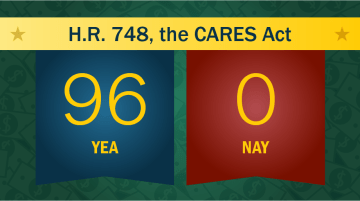This article originally appeared in Education Week
on April 7, 2020. Reprinted with permission from Editorial Projects in Education.
Even with $13.5 billion in coronavirus relief aid provided to schools by Congress last month, an across-the-board 8 percent cut to states’ school funding would lead to a decline in per-pupil spending in all 50 states, a new analysis shows.
In addition, the analysis by Michael Griffith, a veteran school finance consultant, finds that the K-12 relief package signed by President Donald Trump on March 27 as part of the Coronavirus Aid, Relief, and Economic Security Act amounts to less than 2 percent of all spending on public schools.
As a souring economy eats into states’ resources this year, the emergency airlift of federal money could help mitigate the damage to the nation as a whole and states in particular.
Yet already, states are seeing their economies start to slide and are slashing their spending. For example, Idaho Gov. Brad Little, a Republican, has already ordered the state education department and other agencies to shave 1 percent off their budgets. And last month, New York Gov. Andrew Cuomo, a Democrat, said the state could have a $15 billion shortfall in tax revenue. And the education community has put Congress and the White House on notice that the current round of federal aid won’t be enough to keep school budgets from a sharp decline.
Some observers already anxiously foresee a round of cuts similar to the impact on school budgets triggered by the Great Recession of 2007 to 2009, which some evidence indicates hurt students’ performance and their odds of going to college, particularly for students of color. The extent to which per-pupil spending has rebounded since the Great Recession varies significantly between states.
Some observers already anxiously foresee a round of cuts similar to the impact on school budgets triggered by the Great Recession of 2007 to 2009.
The CARES Act, signed by President Donald Trump on March 27, includes billions earmarked for public schools. There’s a $13.5 billion pot for school districts, which will go out to districts under an existing federal formula focused on disadvantaged students, and a $3 billion fund for governors to distribute to both K-12 and higher education.
